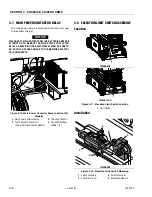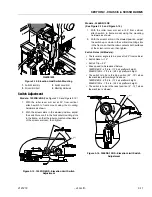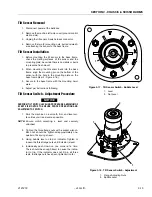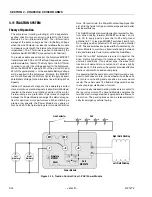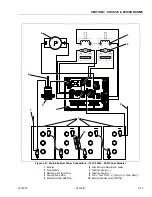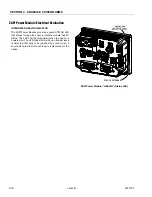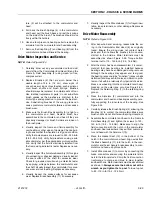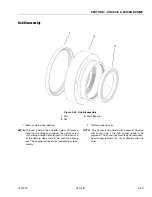
SECTION 3 - CHASSIS & SCISSOR ARMS
3-14
– JLG Lift –
3121273
3.11 TRACTION SYSTEM
Theory of Operation
The armatures (rotating windings) of the separately-
excited drive motors are wired in parallel to the Power
Module's -T and +B terminals (ZAPI) . The +B Terminal is
always at the same voltage as the +B (Battery Voltage
when the Line Contactor is closed) and allows the module
to measure current with the internal shunt (extremely low
impedance). The -T Terminal is pulled to Ground by the
Armature Switch MOSFET's (connected to -B Terminal).
To provide variable speed control, the Armature MOSFET
transistors switch On and Off at high frequencies (pulse-
width modulation; 16kHz). The Duty Cycle (On & Off time)
is varied to control the voltage applied to the Armatures.
When the MOSFET's spend 50% of the period On and
50% Off, approximately ½ of the available Battery Voltage
will be applied to the Armatures. Similarly, the MOSFET
are On continuously (100% Duty Cycle) to apply all avail-
able Battery Voltage to the Armatures (as in Driving at Full
Speed).
Instead of permanent magnets, the separately-excited
drive motors use electro-magnets (called Field Windings)
located in the stator (non-rotating) portion of the motor.
Field windings are preferable to permanent magnets
because the Power Module can adjust the stator's magne-
tism for optimum motor performance. When climbing a
grade a low speeds, the Power Module may apply as
much as 40A to the field windings for more electro-motive
force. On level terrain, the Power Module will apply as little
as 14A to the fields for higher rotational speeds and better
electrical efficiency.
The Field Windings also provide direction reversal for trac-
tion. When driving forward, MOSFET switches 1 and 4
turn On to apply positive potential to F2 and ground
potential to F1. In reverse, MOSFET switches 2 and 3 turn
On to apply positive potential to F1 and ground potential
to F2. Theses switches are pulse-width modulated by the
Power Module to maintain a fixed relationship between
Field and Armature Current (also called the Field Map).
Since the two 24V Armatures are wired in parallel, the
drive motors will attempt to rotate at the same speed
under all conditions. If one wheel slips, the wheel with
traction will demand more current as it slows slightly
(under load). In this manner, the system provides effective
traction control with no added complexity.
It is essential that the same amount of field current is sup-
plied to both drive motors, or one wheel will pull the vehi-
cle (motor overheating and excessive tire wear would
result). The vehicle uses 12V field windings wired in series
to ensure proper distribution of current.
Two electrically-released parking brakes are mounted to
the rear drive motors. The Ground Module energizes the
two 24V electro-magnets when appropriate to allow vehi-
cle motion. The parking brakes can be released electri-
cally for emergency vehicle towing.
Figure 3-19. Traction Control Circuit - ZAPI Power Module
+
24V
+
+
+
Line Contactor
Right Field Winding
Left Field Winding
Power Module
Left
Armature
Right
Armature
+
+
BF1
BF2
B
+B
T
F1
F2
Field
MOSFETS
Armature
MOSFET
Shunt











